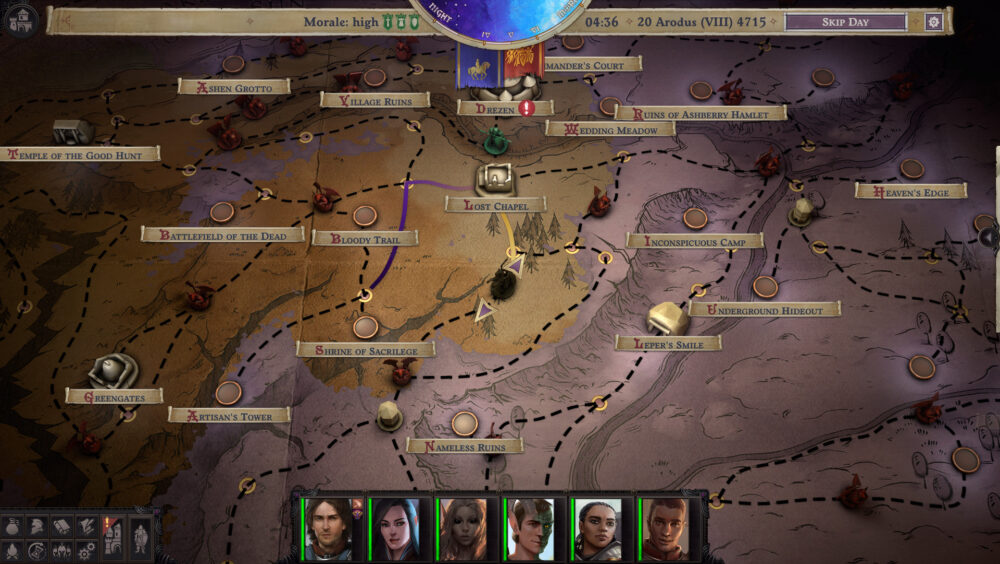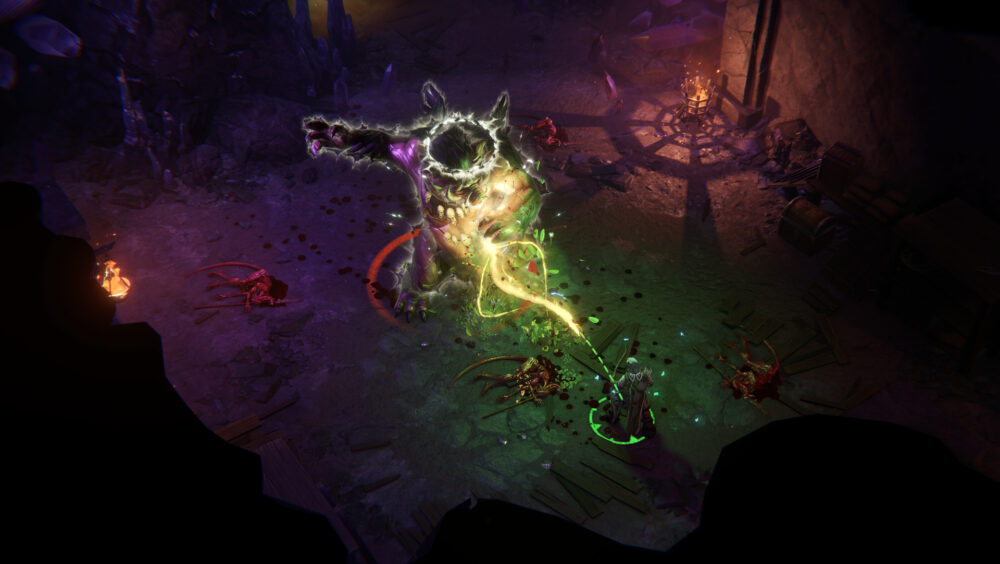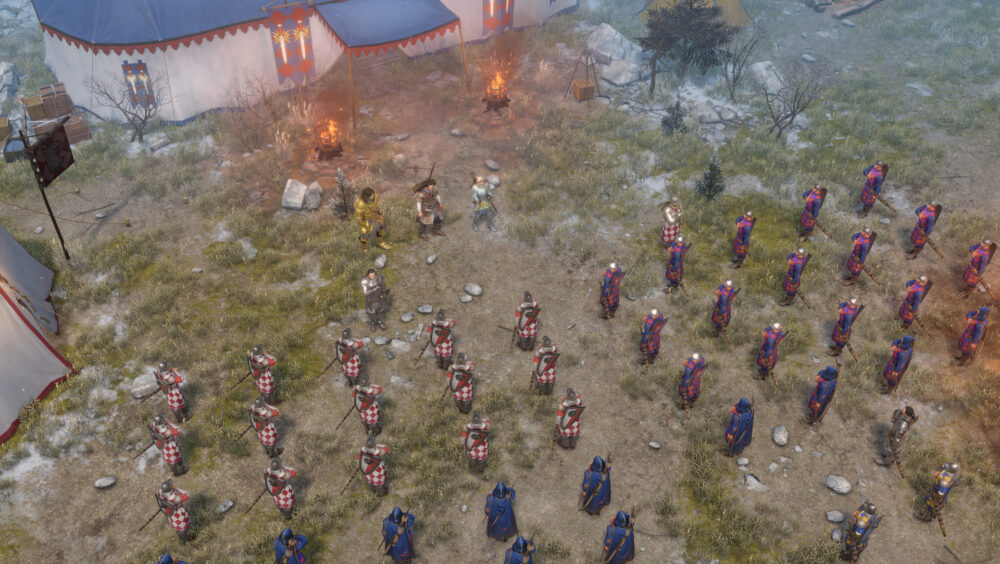Arriving 4 years after the first game, Owlcat has recently released the second Pathfinder-styled video game in the form of Wrath of the Righteous, which just like the previous follows an adventurer path designed for the tabletop roleplaying game. Changing the rules and story to better fit a video game that lacks a GameMaster, PF: WotR is a heaven-sent gift for forever GMs who never get to play the TTRPG. Whilst not a sequel in any real sense, WotR keeps plenty of mechanics, models, items, art, and music from Kingmaker, making it a very easy game to come to grips with though also feels somewhat lazy in some areas of design.
Starting off with a much better beginning, WotR’s introduction shows off the slightly updated graphics, effects, alongside the much-loved mod of the first game that adds in a rotatable camera. We are given a brief explanation of our characters circumstance of being knocked out and wounded by the demons that harrow the lands, to be healed up and given one of 9 choices that denote a bit more of our background. Sadly, a lot of these won’t matter as WotR is a lot more railroaded in its design to force you into joining the crusade.

From the healing of our wounds we’re free to enjoy a festival for it to become overrun by demons, the protectors killed, and us falling into a pit in the floor to get to the real meat of the game. After making our way through the undergrounds we are treated to a smidgen of divine powers with an angelic sword, start a small uprising of the underground folk, and working to take back the city of Kenabres from the demons.
The game spirals from a singular adventure to stay alive, then saving a single city, to eventually saving the world and fighting gods. Typical RPG shenanigans, though somewhat more powerful due to the use of the Mythic system that grants the characters actual godly powers. Coming from Kingmaker, players will see a definite spike in power and a variety of actions at play. This may be a downfall later, however, as not all adventure paths use the mythic system, and moving from all this power to one without it may put some players off.

The main story of WotR will run you around 80 to 120 hours depending on how much of the content you engage with, similar to Kingmaker’s runtime of the same amount barring DLCs. Even though the game features a multitude of choices, including the mythic path you go down, the sheer length of the title may push many away from multiple playthroughs, at least straight away. The game easily has enough for a solid 3 to 5 runs with differing outcomes if you have that amount of time to spare.
The gameplay of WotR is incredibly similar to Kingmaker, as it follows the pathfinder rulebook for about 80% accuracy. Generally, you click on parts of the map to move, interact with objects to gather loot or change the environment, and enter into combat when you get close enough to enemies or surprise them with pre-emptive action.
Combat can work in either real-time, where actions require a number of seconds to occur, or turn-based where all characters take their turn on their assigned imitative roll and wait for the next person to go. Turn-based is the easier yet longer way to play, as a character can take all their actions at once, whereas in real-time their attacks must wait so many seconds before going off which allows enemies to interrupt or move out of the way. These two forms of play drastically affect the playtime, saving an easy 5 or more hours if you play totally in real-time.

As you defeat enemies, succeed in skill checks, and complete quests, you’ll be rewarded experience which allows you to level up at certain intervals. You can continue your current class’s progression or multiclass into any other class you can apply for, and eventually prestige classes that have more prerequisites. In Pathfinder you’re more than likely going to want to stick to a single class, though dipping a few levels into another class can be extremely powerful if you know a good enough build, like a Hunter who uses Wisdom for their diplomacy rolls and their attacks rolls if they dip into Zen Archer archetype of the Monk class and take the acolyte background skill.
Knowledge of the TTRPG version of Pathfinder can make WotR much easier, though the video game version does differ on many different portions of the rules. Being prone allows no action besides standing, ranges are far reduced, saves and effects are slightly altered, traps do not work as they should do, and short-rests don’t typically exist, among many more. It isn’t too far of a cry away from the tabletop, but it is something to note for the rule-lawyers.

Aside from normal combat and traversal, WotR changes out the kingdom management of Kingmaker for a crusade mechanic. More akin to champion-controlled RTS games, you move your army across the world map to fight back against demons. Once in combat you have a large grid to move your troops around on, use their skills, or attack the opponent. Your commander can be chosen from a wide variety of classes, gaining access to buffs to their team, more troop allowances, magical spells, and more. As you win fights, take over nodes, and pass time, you’ll accrue three different resources to build up structures and buy more troops.
The crusading mechanic is much faster and action-based than the kingdom management of the previous title and should appeal to a wider audience. I personally loved the mechanic as I got more into it, with new systems opening up as well as learning the mechanic as I went along. It does start out a bit rough, as not everything is explained succinctly, but trial and error save the day. Once the beginning segments are dealt with you gain access to more choices and buildings, to better control and upgrade your armies.

Sadly, the music of WotR features many reused tracks of Kingmaker, especially the main theme, tavern theme, alongside one or two traversal and combat tracks. Aside from the reused content, the main soundtrack contains many amazing songs to back your movement across the world and engaging you within epic battles more. However, just like its predecessor, WotR’s music has consistently terrible looping songs for events with some not even looping and just leaving you in silence. Many times where the songs do loop, the songs are way too noticeable towards the end and beginning, with harsh looping songs that end abruptly, have some silence, and then start loud.
The graphics of WotR haven’t taken an amazing jump in quality from Kingmaker, with several icons, models, and effects being directly pulled from the previous games. You will notice a slight change, possibly due to the addition of more tieflings, wings, halos, and effects, that the overall feel is improved but for people coming straight off the heels of Kingmaker they may feel a bit cheated in that regard. Encounter maps continued to be repeated, with the city having possibly 3 variants and the world map having 2 or 3 per section.

Since WotR is based on a previous title, alongside a TTRPG, the difficulty can change quite a bit based on your knowledge of the systems at play. However, the video game does jack up DCs, encounter numbers, as well as how certain actions work to make it more challenging. If you play on the normal difficulty, you will find it an alright experience aside from boss fights or times where you haven’t rested. Bumping up one or two difficulty levels will cause the game to feel immensely brutal to all by those who are proficient in Pathfinder. Thankfully there seems to be a lack of fights against enemies of 10 CR higher than your level in this title, which felt more like a newbie trap in Kingmaker.
For fans of Pathfinder, WotR is a well put together ride on one of the more well-known adventure paths. It fits just enough of the ruleset into a video game to make it the most outstanding member of Pathfinder titles. It does change a lot, but not enough to make it a bad experience. Dungeon maps are more expansive and intricately designed than the previous title, instead of the boring caves with copy-pasted corridors.

Overall, Pathfinder: Wrath of the Righteous gets an 8/10. It is a step above its predecessor, though still features too many of its last’s faults and bugs. As time goes on and the developers can fix the glitches, implement balanced changes alongside new content, I can easily see it reach into the 8.5 or even 9 regions. The story is engaging, gameplay fun, with some flashy graphics to show off your godly powers. Fans of the first title, or the TTRPG, should love this release and I hope to see it continue to flourish.
You can purchase this game on PC via Steam here for £42.99
Developer: Owlcat Games
Publishers: Owlcat Games, Paizo, META Publishing, Koch Media, Deep Silver
Platforms: PlayStation 4, macOS, Microsoft Windows, Macintosh operating systems, Xbox One
Enjoy the review? want to read more of our reviews? then click right here to be whisked away to the realm of our opinions.








You must be logged in to post a comment.